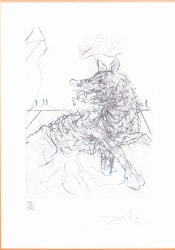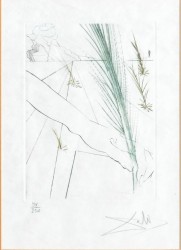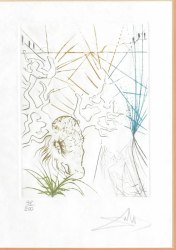Salvador Dali 1904 - 1989
Represented by:
O-68
Salvador Dalí was an icon of surrealism, the 20th-century avant-garde movement that wanted to release creative potential through art with hyper-realistic fantasy images. Dalí's fantastic prints, paintings, sculptures, films and writings helped solidify the movement's identity. Dalí worked with psychoanalytic ideas and created fantastic creatures and landscapes. His 1931 canvas The Persistence of Memory is one of the most recognizable works of art of all time. Dalí exhibited widely during his lifetime and his works are in the collections of institutions including the Tate Modern Art Museum in London and the Art Institute in Chicago.
In 1950, the Italian government commissioned Dali to illustrate Dante Alighieri's (1265-1321) Divine Commedia (1307) for a publication celebrating the 700th anniversary of Dante's birth. Dali created 100 watercolors (1950 - 1959) illustrating each of the 100 cantos of Dante's masterpiece. But the Italian public was outraged that a Spaniard had to illustrate the work of their great national poet, it had to be done by an Italian.
Dali then presented his 100 watercolors to the French printer Jean Forêt, who agreed to publish the text of the Divine Commedia in French with Dali's illustrations. To achieve this, the watercolors had to be made suitable for printing. It took 50 months (April 1959 – November 1963) to engrave the approximately 3,500 woodblocks: an average of 35 blocks were needed to represent the rich color palette of each of the 100 watercolors. Unlike woodcuts, where cuts are made along the grain of the wood, wood engravings are made into the end grain of a wood block, allowing the creation of thin delicate lines as well as large areas of color.
The work was published in an edition of 4,765 copies by Les Heures Claires publishers. Art Gallery O-68 acquired a numbered copy (№ 2309). The complete set consists of 12 parts: 2 for each of the three parts Inferno, Purgatorio and Paradiso and 6 complete sets of decompositions. Decompositions are prints of each individual woodblock showing each stage in the printing process by separately making a print of woodblock 1, then woodblock 2 and then the combination of woodblock 1 + 2, then woodblock 3 followed by the combination of 1 + 2 + 3, etc. to the full picture.
In 1950, the Italian government commissioned Dali to illustrate Dante Alighieri's (1265-1321) Divine Commedia (1307) for a publication celebrating the 700th anniversary of Dante's birth. Dali created 100 watercolors (1950 - 1959) illustrating each of the 100 cantos of Dante's masterpiece. But the Italian public was outraged that a Spaniard had to illustrate the work of their great national poet, it had to be done by an Italian.
Dali then presented his 100 watercolors to the French printer Jean Forêt, who agreed to publish the text of the Divine Commedia in French with Dali's illustrations. To achieve this, the watercolors had to be made suitable for printing. It took 50 months (April 1959 – November 1963) to engrave the approximately 3,500 woodblocks: an average of 35 blocks were needed to represent the rich color palette of each of the 100 watercolors. Unlike woodcuts, where cuts are made along the grain of the wood, wood engravings are made into the end grain of a wood block, allowing the creation of thin delicate lines as well as large areas of color.
The work was published in an edition of 4,765 copies by Les Heures Claires publishers. Art Gallery O-68 acquired a numbered copy (№ 2309). The complete set consists of 12 parts: 2 for each of the three parts Inferno, Purgatorio and Paradiso and 6 complete sets of decompositions. Decompositions are prints of each individual woodblock showing each stage in the printing process by separately making a print of woodblock 1, then woodblock 2 and then the combination of woodblock 1 + 2, then woodblock 3 followed by the combination of 1 + 2 + 3, etc. to the full picture.
Artworks
Articles
Media
Highlights
Recommendations
Collections
Shows
Market position
CV
Shows
Free Magazine Subscription
Articles, interviews, shows & events. Delivered to your mailbox weekly.









